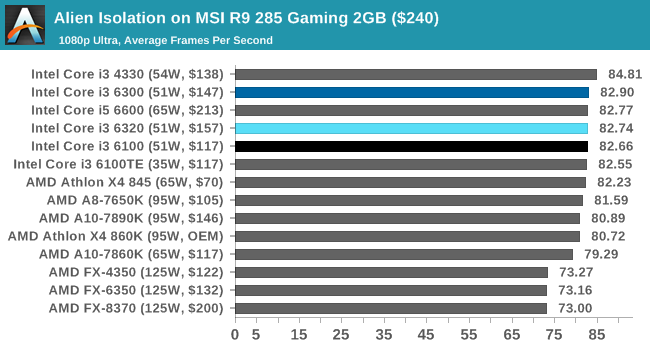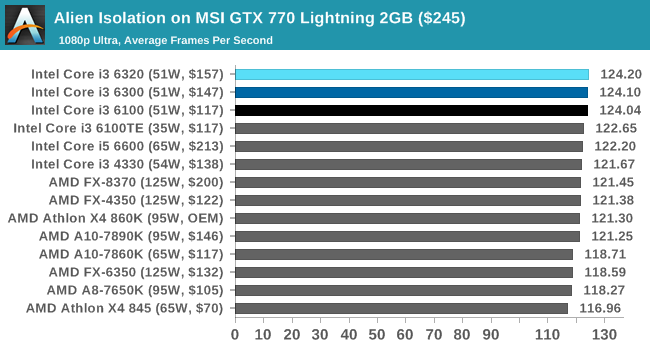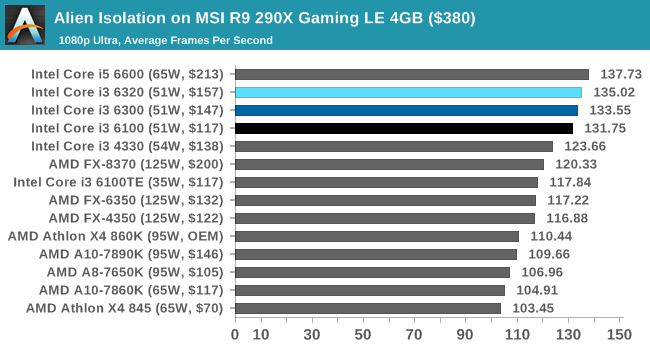The Skylake Core i3 (51W) CPU Review: i3-6320, i3-6300 and i3-6100 Tested
by Ian Cutress on August 8, 2016 9:00 AM ESTAlien: Isolation
If first person survival mixed with horror is your sort of thing, then Alien: Isolation, based off of the Alien franchise, should be an interesting title. Developed by The Creative Assembly and released in October 2014, Alien: Isolation has won numerous awards from Game Of The Year to several top 10s/25s and Best Horror titles, ratcheting up over a million sales by February 2015. Alien: Isolation uses a custom built engine which includes dynamic sound effects and should be fully multi-core enabled. We take the average frame rate as our marker with a scripted version of the built-in benchmark.
For this test we used the following settings with our graphics cards:
| Alien Isolation Settings | |||
| Resolution | Quality | ||
| Low GPU | Integrated Graphics | 1280x720 | Ultra |
| ASUS R7 240 1GB DDR3 | |||
| Medium GPU | MSI GTX 770 Lightning 2GB | 1920x1080 | Ultra |
| MSI R9 285 Gaming 2G | |||
| High GPU | ASUS GTX 980 Strix 4GB | 1920x1080 | Ultra |
| MSI R9 290X Gaming 4G | |||
Alien Isolation seems to have recently had an update that affects low powered GPUs, pushing our new results to be very different to the results in our database. It only seems to affect the IGP and R7 240 results, so for now we'll focus on the other data.




In each case the Core i3s perform at the top or near the top, with the higher frame rates being with the higher frequency parts. However, for our mid-range GPUs (R9 285, GTX 770), that doesn't seem to matter that much, and the $70 AMD Athlon X4 845, along with the A10 parts, are within shouting distance. However, the effect gets worse with higher power GPUs, with the graphs taking an Intel/AMD split almost. The 8-thread AMD FX part sits as close as it can, but the Skylake parts pull a 10+ FPS advantage, which equates to an 8% or better difference.











94 Comments
View All Comments
nightbringer57 - Monday, August 8, 2016 - link
Hard question.My guess would be that such models are core i3s with defective iGPUs, and overall lower binned, mostly destined to OEMs that could negotiate a lower price for almost identical performance (3% less frequency = no noticeable difference), in models with typically low-end dGPUs. While at the same time not price dumping the other i3s in the retail market (prices are always much more variable than the MSRP in the retail market and I would guess you could find them for slightly cheaper).
Once again, 3% frequency and 3W TDP don't make for much of a difference.
DanNeely - Monday, August 8, 2016 - link
Yeah it definitely looks like a binning dumpster - trying to salvage the last bit of value from chips with working HT but a damaged GPU that needed partially fused off. If the list price was marginally lower I wouldn't've thought anything of it, although I suppose Intel could be willing to offer better volume discounts behind the scenes.extide - Monday, August 8, 2016 - link
Yup, the 6098P has GT1 graphics, with only 12 EU's, vs GT2 and 24 EU's in all of the other i3's. I bet they are harvesting chips with bad EU's. As far as price goes, I am sure that whatever OEM is buying those is paying less than the prices on ARK. Intel is kinda famous for having tons of CPU's all the same price, but the OEM's buying them are going ot be paying totally different prices than whats on the price sheets/ARK. I would imagine the prices that they negotiate end up being lower for the lower models and higher for the higher models even if they are all listed the same on ARK.Ratman6161 - Monday, August 8, 2016 - link
I did a quick check and did not find any 6098's for sale on New Egg or Amazon. But I could see a position for them if the street price is less than a 6100. For anyone who is not going to use the integrated graphics anyway, saving a few more bucks on the CPU could be worthwhile. Has to be cheaper than a 6100 though because otherwise you would just get the 6100.Since I'm not finding any for sale, I'm also wondering if they will mainly be sold to OEM's and end up with people who wouldn't know the difference anyway in their low end Dell or HP desktop?
kuntakinte - Monday, August 8, 2016 - link
Nice selective test :-). In comparision with rather old i3-4330 (3,5GHz) Skylake shines.But maybe you can add to the charts fastest i3 Haswell (i3-4370, 3,8 GHz). It's exactly in the middle of the tested three cpu's. But then i supose that Skylake "advantage" will drop to mere 2-5%.
lefty2 - Monday, August 8, 2016 - link
Actually, I was surprised that the iGPU sees zero improvement since Haswell.ImSpartacus - Monday, August 8, 2016 - link
This is an awesome subject that I've fascinated by. Good to see a proper review.AndrewJacksonZA - Monday, August 8, 2016 - link
Interesting that you kept the WinRAR test and let the 7-Zip test go to the "Legacy" section. Why? Did you do a coin toss between the two? :-)stephenbrooks - Monday, August 8, 2016 - link
Right... a friend actually persuaded me to migrate *from* WinRAR *to* 7-Zip because it offered better compression.DanNeely - Monday, August 8, 2016 - link
As a file compression utility, 7zip is better than WinRar. Where Winrar stands out is as one of the very few real world applications whose performance is hugely dependent on memory speed; which makes it a great benchmark.